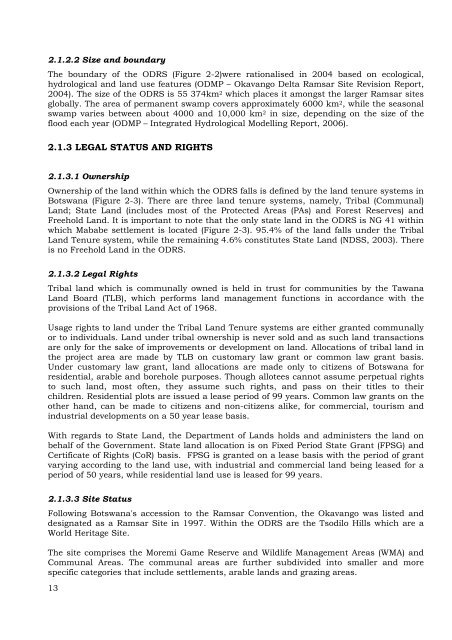Okavango Delta Management Plan - Ramsar Convention on Wetlands
Okavango Delta Management Plan - Ramsar Convention on Wetlands
Okavango Delta Management Plan - Ramsar Convention on Wetlands
Create successful ePaper yourself
Turn your PDF publications into a flip-book with our unique Google optimized e-Paper software.
2.1.2.2 Size and boundary<br />
The boundary of the ODRS (Figure 2-2)were rati<strong>on</strong>alised in 2004 based <strong>on</strong> ecological,<br />
hydrological and land use features (ODMP – <str<strong>on</strong>g>Okavango</str<strong>on</strong>g> <str<strong>on</strong>g>Delta</str<strong>on</strong>g> <str<strong>on</strong>g>Ramsar</str<strong>on</strong>g> Site Revisi<strong>on</strong> Report,<br />
2004). The size of the ODRS is 55 374km2 which places it am<strong>on</strong>gst the larger <str<strong>on</strong>g>Ramsar</str<strong>on</strong>g> sites<br />
globally. The area of permanent swamp covers approximately 6000 km2, while the seas<strong>on</strong>al<br />
swamp varies between about 4000 and 10,000 km2 in size, depending <strong>on</strong> the size of the<br />
flood each year (ODMP – Integrated Hydrological Modelling Report, 2006).<br />
2.1.3 LEGAL STATUS AND RIGHTS<br />
2.1.3.1 Ownership<br />
Ownership of the land within which the ODRS falls is defined by the land tenure systems in<br />
Botswana (Figure 2-3). There are three land tenure systems, namely, Tribal (Communal)<br />
Land; State Land (includes most of the Protected Areas (PAs) and Forest Reserves) and<br />
Freehold Land. It is important to note that the <strong>on</strong>ly state land in the ODRS is NG 41 within<br />
which Mababe settlement is located (Figure 2-3). 95.4% of the land falls under the Tribal<br />
Land Tenure system, while the remaining 4.6% c<strong>on</strong>stitutes State Land (NDSS, 2003). There<br />
is no Freehold Land in the ODRS.<br />
2.1.3.2 Legal Rights<br />
Tribal land which is communally owned is held in trust for communities by the Tawana<br />
Land Board (TLB), which performs land management functi<strong>on</strong>s in accordance with the<br />
provisi<strong>on</strong>s of the Tribal Land Act of 1968.<br />
Usage rights to land under the Tribal Land Tenure systems are either granted communally<br />
or to individuals. Land under tribal ownership is never sold and as such land transacti<strong>on</strong>s<br />
are <strong>on</strong>ly for the sake of improvements or development <strong>on</strong> land. Allocati<strong>on</strong>s of tribal land in<br />
the project area are made by TLB <strong>on</strong> customary law grant or comm<strong>on</strong> law grant basis.<br />
Under customary law grant, land allocati<strong>on</strong>s are made <strong>on</strong>ly to citizens of Botswana for<br />
residential, arable and borehole purposes. Though allotees cannot assume perpetual rights<br />
to such land, most often, they assume such rights, and pass <strong>on</strong> their titles to their<br />
children. Residential plots are issued a lease period of 99 years. Comm<strong>on</strong> law grants <strong>on</strong> the<br />
other hand, can be made to citizens and n<strong>on</strong>-citizens alike, for commercial, tourism and<br />
industrial developments <strong>on</strong> a 50 year lease basis.<br />
With regards to State Land, the Department of Lands holds and administers the land <strong>on</strong><br />
behalf of the Government. State land allocati<strong>on</strong> is <strong>on</strong> Fixed Period State Grant (FPSG) and<br />
Certificate of Rights (CoR) basis. FPSG is granted <strong>on</strong> a lease basis with the period of grant<br />
varying according to the land use, with industrial and commercial land being leased for a<br />
period of 50 years, while residential land use is leased for 99 years.<br />
2.1.3.3 Site Status<br />
Following Botswana's accessi<strong>on</strong> to the <str<strong>on</strong>g>Ramsar</str<strong>on</strong>g> <str<strong>on</strong>g>C<strong>on</strong>venti<strong>on</strong></str<strong>on</strong>g>, the <str<strong>on</strong>g>Okavango</str<strong>on</strong>g> was listed and<br />
designated as a <str<strong>on</strong>g>Ramsar</str<strong>on</strong>g> Site in 1997. Within the ODRS are the Tsodilo Hills which are a<br />
World Heritage Site.<br />
The site comprises the Moremi Game Reserve and Wildlife <str<strong>on</strong>g>Management</str<strong>on</strong>g> Areas (WMA) and<br />
Communal Areas. The communal areas are further subdivided into smaller and more<br />
specific categories that include settlements, arable lands and grazing areas.<br />
13

















